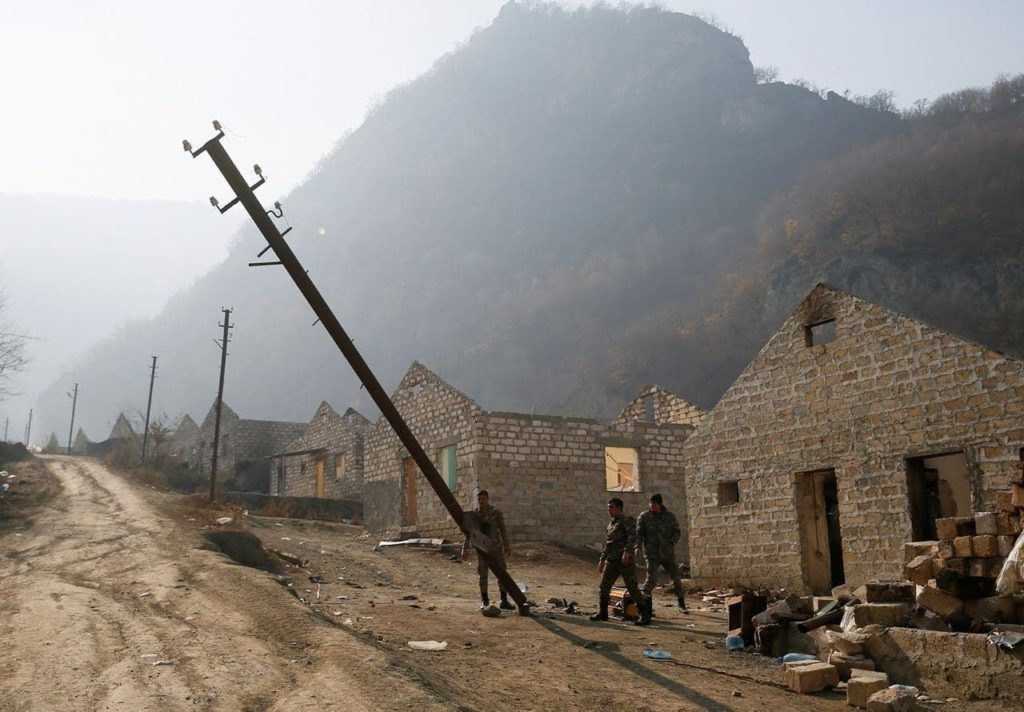The Azerbaijani army has entered the Kalbajar region, one more territory ceded by Armenian forces in a peace agreement that ended deadly fighting over the territory of Nagorno-Karabakh, Azerbaijan’s defence ministry said on Wednesday, Al Jazeera reported.
The agreement which was brokered by Russia two weeks ago, stated that Armenia hand over control to Azerbaijan of some areas its holds.
The first one, Agdam, was turned over last week. Kalbajar was expected to be handed over on November 15, but Azerbaijan agreed to delay the takeover after a request from Armenia. Azerbaijani officials said worsening weather conditions made the withdrawal of Armenian forces and civilians difficult along the single road through mountainous territory that connects the region with Armenia.
Footage on Wednesday showed Azerbaijani troops slowly moving through snowy terrain, looking for mines.
“Engineering work has been completed to ensure the movement of our units in this direction, the difficult mountain roads along the route of the troops’ movement are being cleared of mines and prepared for use,” the Azerbaijani defence ministry said.
Nagorno-Karabakh lies within Azerbaijan but has been under the control of ethnic Armenian forces backed by Armenia since a war there halted with a ceasefire in 1994. That war left not only Nagorno-Karabakh itself but substantial surrounding territory occupied by Armenian forces.
Heavy fighting over Nagorno-Karabakh broke out on September 27 and marked the biggest escalation of the decades-old conflict between the two ex-Soviet nations in more than a quarter-century, killing hundreds and possibly thousands of people.
During this escalation, many cities and towns within Azerbaijan suffered heavy shelling and bombing. Tartar, a town close to the former line of conflict, was one of these cities, suffering heavy losses from the onslaught by Armenian forces, observers tell Conflict & War Report.
Rusif Huseynov, co-founder and director of the Topchubashov Center, an independent think tank based In Baku, said that Tartar was under a perpetual rain of bullets and shelling during the whole period.
“From the first day of the war, Tartar, a city close to the former line of contact, was subject to an uninterrupted rain of bullets and shell by the Armenian armed forces. For 44 days the Tartar inhabitants had to mainly hide in underground shelters, with a few families deciding to evacuate temporarily. Nevertheless, the region could not avoid casualties among the civilian population.” Huseynov tells Conflict & War Report.
“On October 15, a cemetery in Tartar became the target of Armenian forces: out of the funeral participants three got killed, another five severely wounded. On October 24, a Smerch missile attack launched by the Armenian side took the life of a 16-year-old Orkhan Ismayilzada from a village in Tartar, when the teenager was in his family`s garden.” Huseynov added.
The town and its surroundings has been a home for many internally displaced people (IDPs) who had to flee from their original settlements in and around Nagorno-Karabakh.
The latest truce halted the violence after several failed attempts to establish a lasting truce. While it was celebrated as a victory in Azerbaijan, at the same time it sparked mass protests in Armenia, with thousands taking to the streets to demand the resignation of the country’s prime minister.
